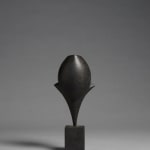Hans Coper 1920-1981
This last series is now generally regarded as a culmination and refinement of everything that Coper had achieved in his career, as Tony Birks describes,
'In this breathtaking collection Hans seems to have carried to the ultimate the purity of form that he had been seeking for so long. The new pots, though small, seem to concentrate energy and to be denser than anything natural. Hans had pursued Mies van de Rohe's maxim, Less means More, and produced his finest forms.' 1
Coper left barely any written records, but he did write a brief introduction to the catalogue of 1969 exhibition at the V&A, in which he explains his approach to his work,
'My concern is with extracting essence rather than with experiment and exploration, the wheel imposes its economy, dictates limits, provides momentum and continuity.
Concentrating on continuous variations of simple themes I become part of the process; I am learning to operate a sensitive instrument which may be resonant to my experience of existence now - in this fantastic century. Practising a craft with ambiguous reference to purpose and function one has occasion to face absurdity. More than anything, somewhat like a demented piano-tuner, one is trying to approximate a phantom pitch. One is apt to take refuge in pseudo-principles which crumble. Still, the routine of work remains. One deals with the facts.'
1 Tony Birks, Hans Coper, Marston House, Yeovil, 2005, p71
Provenance
The Hawley Collection, New York
Exhibitions
New York, Metropolitan Museum, Lucie Rie/Hans Coper — Masterworks by Two British Potters, 15 November 1994- 21 May 1995
Toronto, The Gardiner Museum, Ceramic Modernism, Lucie Rie, Hans Coper and their legacy, May 2002
Literature
Tony Birks, Hans Coper, Marston House, Yeovil, 2005, p183 closely comparable examples illus b/w



